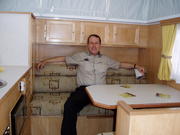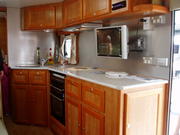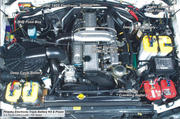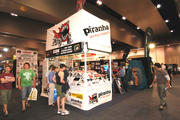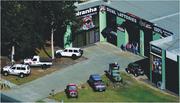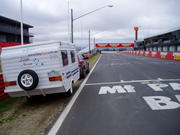Gaz's Gear: Outback Power
Gaz's Gear: Outback Communications | Outback Power | Outback Preparation | Kia and Towing | Home Bar Setup
Outback Power covers a whole range of issues on keeping your everyday appliances charged up when on the road - phones, movie cameras, digital cameras, torches, computers, PDA's...... the list is endless these days. And they're just the little portable devices we all take for granted in the city!
But what about fridges, lights, cooking appliances, entertainment units and even washing machines these days, in the big rigs towed into the outback?
In an emergency, it is important that you not only have communications, but also the power to use them - sometimes for longer than planned!
But how do you get power? Well that depends on where you are, how long you need it for, what you need it for, and what accommodation, transport or situation you are in at the time.
We'll take a look at all these issues, consider the position of 4WDs, campers, rental drivers, the walker and the jet-setter - they all have slightly different needs for powering all their equipment from different sources.
Time versus Power, and what we need power for
When considering a power source, the one single overlooked issue is 'TIME'. At home or in the office, power is one of those things that seems to just be there. Flick on the power switch, or push the button on the gas appliance and presto, you're enjoying the facility. That's because you're surrounded by an 'always available' power source. Let's face it, we do tend to take it for granted, don't we?
Even jumping in the car and driving to work - you have your PDA plugged in, you're listening to the radio, your GPS is guiding you down all the wrong congested roads (opps! - need one of those interactive traffic monitoring models!), the air-conditioner's kicked in, and maybe the family are watching DVD's in the back seat on their latest mobile gadget.
So long as the car engine keeps running and the battery is big enough, you just may get away with all this gear running - but add the wipers and high beam lights on a wet night, and now you're starting to push the limits of your power source. And that's with the engine running and generating the power.
But it's a totally different situation when travelling for a few days or weeks or more. The first day's fine, because it's just like the drive to the office above. But on the days that follow, when the vehicle is at your favourite campsite or motel, and the engine is no longer running, keeping the battery charged up becomes a serious question.
Where do you expect to get an ongoing source of power from your car battery, that's still running some of these 'always-on' gadgets? Or maybe I should ask - did you bring your Jump-Start portable power pack with you, for your now flat battery?
The same applies to auxilliary battery configurations, whether it is a dual-battery system in a car/4WD or perhaps a vehicle coupled with a caravan/camper scenario with auxilliary batteries in the camper. Everything works fine for the first few days, and then you have to figure out where to get some more power from, unless it is storing what you need for the days ahead.
I call this the 'day 3 power saga'
Power sources
Let's look at the many power sources available for a moment:
- auxillary battery types: Cranking (for maximum power for a short time - winching engine starting), Deep Cycle (for low amperage drain over a longer time, for fridges, radios), Hybrid (a compromised battery to handle both the above functions), SLA (Sealed Lead Acid) or GEL (Gelified Electrolyte lead acid battery). The latter two are modest capacity, small profile batteries offering faster recharge times
- portable gas
- solar panels: fixed or portable
- generators run on fuel
- ancillary car generators for auxillary sources
- spirit/butane fuelled appliances - the old Shellite fuelled stoves still cook quicker and more efficient compared to gas - great for walkers/campers!
- traditional fire and ice (can't beat the natural stuff!)
- wind powered generators are an often overlooked power source, despite their sometimes noisy operation due to the sheer speed of the wing-tips
- small appliance batteries, and rechargeable battery items (AAA to D, Lithium, NiCAD, and the new emerging ultra Farad Capacitor styled fuel cells)
- and of course, somebody else's electricity supply!
- and all manner of combinations of the above, if necessary, linked up to support one another.
Don't think I've forgotten you light-travelling jet-setters. Just because you're not hauling around your home on a towbar or roofrack, doesn't mean you can skip the check list!
You especially need to think about those little extras that make your gadgets keep running - and if travelling overseas, then all them will need converters for the local power source and wall connection type.
Don't forget to take all those special cables and charger-packs for your mobile phone, camera, movie camera and any other personal device that you're used to plugging in back at home every night.
Otherwise, they'll all STOP on day 3!
Appliances needing power
When travelling in your rig with your favourite gear, just what are the items that power is needed for?
- lights
- cooking: stove, microwave, griller
- cooking appliances: jugs, toaster, frypan, fucaccia maker (I like facaccias!)
- refrigeration
- drink coolers
- heating
- cooling
- entertainment: radio, TV, DVD, music
- personal appliances: clocks, hairdryers, shavers
- communications: mobile phone, 2-way, RFDS, UHF/CB (or in my case, ABSoutback Mobile Internet equipment)
- computers - these days more and more travelelrs are taking photos, editing them and burning DVD's
- GPS mapping devices and Navigational aids all require continuous power these days, in vehicles, and often wehn the engine is stopped
- power showers - another power consuming device from the vehicle or van, when the engine is not running
- portable styled washing/drying machines
- water pumps and sullage/sanitary systems
- rechargers to top up portable batteries for the likes of movie cameras, phones, PDAs, digital cameras, rechargeable torches
- and there's sure to be lots others......
That's a lot of appliances, and depending on how far away you are from conventional power sources like electricity, and how far it is to drive to a general store to get refills, you need to consider how you can live with just your own power sources. And don't forget - sometimes things go wrong, like the wet season comes early and the roads are cut for longer that expected. But more than likely, you've discovered that little piece of tranquility you want to enjoy for a few more days - still on the same limited power sources!
Again, TIME is the key element to consider with all these appliances. If you are away from an electrical power source for many days, and don't drive your vehicle to recharge all the auxillary battery systems, then care must be taken to ensure you have enough power capacity to run all your favourite gear.
Power Showers are growing in interest for those who haven't invested heavily in a full ensuite caravan. And here's an interesting power consuming device one: Power Cleaners. A combination of compressor and power shower setup that lets you clean away any evidence of playing up in your rig!
Off road repairs are also something that more and more serious offroaders are doing these days. "Weekend Warriers" enjoying their 4WD rigs out in the bush are turning to using some great portabnle welding kits these days, for on-the-job repairs to fuel tanks, shockers, springs - you name it. Another appliance needing a power source. The list grows.....
Okay, I've got my power plan, but what about precautions?

still lining up at the shows to discover some clues? - look no further
Planning the power sources to best suit each appliance is one thing. Now to consider how they all link up so that you don't damage or drain some other important power source or circuit.
One of the usual issues, is how to protect the car's primary battery whilst running auxillary batteries for appliances. You need to be able to crank the engine next morning, and if you're in cold climates, cranking a high compression engine - well, that needs every square inch of power a basic battery has to offer.
So here's a few guidelines:
- allow for wear'n'tear, age and climate of the power source (ie: the main battery of the car for instance)
- consider situations where you may have driven to your destination late, in bad weather conditions, and semi-depleted the main battery by the time of arrival
- calculate the right sized main battery to cope with this situation, and then consider getting a bigger one anyway
- setup your in-vehicle ancillary appliances to run from an auxillary power source instead
- configure your car batteries to always use a 'one way flow' so that auxillary batteries never drain the main battery
- ensure that there is 'current limiting' installed to isolate auxillary batteries if overloaded
- use quality materials and minimise the number of joints and connectors, to ensure optimal performance of the whole circuit
- only use equipment that is compatible with whatever type of EFI, diesel or petrol model you have - they can vary in requirements
- include spike and surge protection devices to also suit the type of vehicle you have
- allow for the possibility of incorporating different sizes, types, age or design of batteries in the one configuration - be flexible!
- have adequate monitoring facilities to measure the state and capacity of power in the system from all sources
- ensure that the mounting hardware, brackets and assemblies are well manufactured to avoid corrosion, and capable of handling the rigors and stress of travel into rough and remote areas in often extreme temperatures and conditions.
Always use the proper grading and dimension of wiring to suit the application, and have it professionally installed in a way that does NOT conflict with car, camper, trailer or caravan, and accessory manufacturer warranties and guidelines.
A well designed, installed and utilised intelligent dual battery management system can provide a lot of enjoyment to you when travelling into the more outback areas.
In all the years I've been travelling, I've been confronted with the need to sort out many of the above issues, in different vehicles and vans, and with different requirements.
One company I can highly recommend, that has been devoted to solving such challenges and catering for the needs of outback travellers, is Piranha - Off Road products, located in Boronia, Victoria. You can get a lot of great information from their website at: www.piranhaoffroad.com.au
This family run business, is a 100% Australian owned manufacturer and distributor of highly specialised products for the off road 4WD industry, and has been in operation since the early 1980's. Alan and Barbara Johnson, and their team offer brilliant, practical and worthwhile advice on :
- dual battery systems,
- isolators
- inverters
- driving lights - HID, Halogen
- portable lighting - efficient LED and fluoro
- power showers
- 4WD accessories
- recovery gear, winches
- portable power packs
Now don't think you have to be really serious off road 4WD enthusiast to talk to Piranha. Whilst that market has a greater need for self-contained power solutions than most, we hope this Gaz's Gear article has helped demonstrate that everybody travelling out of the city will eventually need to solve power related issues for all their gear - so talk to the those 'in the know' who have solutions for your particular situation.
Gaz's tip!
I recommend you contact Piranha on 03-97621200 for techncial help on any of the matters mentioned here - they have a great national dealer network right across Australia. They offer prompt, courteous and very personal service - no technical query is ever an issue to them. So give their Head Office a call at any time, and they'll put you in the right power direction. (Gaz!)
Time to Power on.........
I hope these ideas will prompt travellers to make their own checklists, and never get caught without the power to use all their favourite 'Gear'! Check out our other topics, and see what "Gaz's Gear" is all about.
Enjoy the journey, not just the destination!
Gaz
Gary Pope
GdayPUBS.com.au
Ph: 0408994799
Introduction: What are Pub Trails?
NOTE
These articles in Gaz's Gear, are independently presented in good faith, to help travellers who want to enjoy some really great Pub Trail journeys giving some extra thought to being best prepared to get the best from the experience.
Opinions, comments and technical content presented here are for general reader interest only, and in no way should be construed as any representation, guarantee or association whatsoever with any companies, products or services mentioned as examples or by inference. Readers should strictly observe all manufacturer and reseller recommendations, instructions and all operational requirements provided with any products purchased or used.



